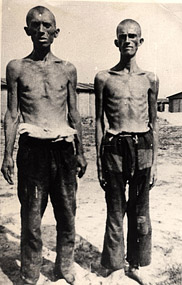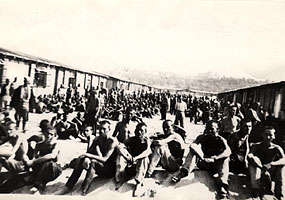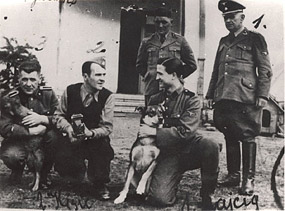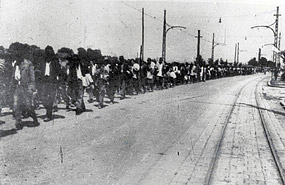English | Srpski
Semlin Anhaltelager (May 1942 - July 1944)
In May 1942, shortly after the last group of Jewish interns was murdered in the mobile gas van, the Semlin concentration camp changed its function. It ceased to be a Judenlager - a camp for Jews - and became an Anhaltelager - a detention camp for political prisoners, captured Partisans and forced labourers most of whom were subsequently deported to Norway, Germany or a number of smaller labour camps in central Serbia. In the spring of 1942, The Third Reich was experiencing a chronic shortage of workforce, so Semlin - located close to the Danube and next to an important railway junction - was transformed into the main distribution centre for forced labour from the whole of the former Yugoslavia. [1]
The first smaller groups of non-Jewish interns started to arrive at Semlin in April 1942, while the gas van operation was still in progress. These groups were swiftly dispatched to labour camps in Northern Europe, although a proportion of interns were put to the more immediate task of sorting the personal belongings of the murdered Jews, which after being stripped of all valuables, were dispatched to Germany.
According to the work of Milan Koljanin, whose monograph on Semlin constitutes the only detailed study of the Anhaltelager, 31,972 interns passed through the camp between May 1942 and July 1944, when the camp was formally abandoned. [2] The vast majority of the interns were Serbs, mostly from Croatia and Bosnia, but also Croats, Bosnian Moslems, Greeks, Albanians and Jews. Of the total number of interns, at least 10,636 perished at the camp and were buried in mass graves at the Jewish cemetery in Zemun (6,500), at the nearby settlement of Bežanija (3,600), at the killing grounds at Jajinci and a small number of other locations near the camp.
In the first eight months of the Anhaltelager (May - December 1942), more than 16,500 interns were brought to Semlin. Of this number, almost 14,000 were from the territory of The Independent State of Croatia, which in the spring of 1942 became the principal battleground of the Partisan insurgency. In addition to the interns from Bosnia and Croatia, 2,800 persons from Nazi occupied Serbia (mainly captured Partisans) were incarcerated at the camp. The largest single consignments of prisoners brought to Semlin were the 10,000 men from the Kozara region in Bosnia, who were captured during a large German military operation in the summer of 1942.
Approximately 4,250 interns died at the Anhaltelager during the first eight months, mostly as a result of disease (above all dysentery) and exhaustion. The summer of 1942 was especially deadly, given that poor sanitary conditions, made worse by overcrowding, provoked a dysentery epidemic. According to camp hospital records, as many as 2,266 interns - weakened by food and water shortage - died during the month of August alone, with a further 1,340 in September.
Apart from exhaustion and disease, a significant cause of death at the camp was the savage beatings carried out by the guards as well as by the camp's internal security force recruited from among the prisoners. The most notorious among the later was a former prisoner named Kisić whose brutality was feared the most. The main victims of these beatings, which more often than not resulted in death, were prisoners who were deemed to be too weak or ill to be transported to labour camps. Also, during various epidemics, interns who displayed symptoms were clubbed to death or shot to prevent the spreading of the disease. The beatings were carried out in the former Hungarian pavilion, which became known among the interns as the 'pavilion of death'. The interns were also routinely subjected to humiliating and exhausting 'physical exercises' and pointless manual labour including carrying boulders from one side of the camp to the other.


Interns of the Semlin Anhaltelager: These photos were not taken at Semlin, but at the nearby labour camp belonging to the Nazi military engineering company 'Todt' which from 1942 onwards relied mainly on forced labour from around Nazi occupied Europe
In the subsequent period - between January 1943 and July 1944 - a further 15,300 interns were brought to Semlin. More than half of this number were captives from the territory of the Independent State of Croatia (8,400 persons), with a further 1,400 from the territory of Nazi occupied Serbia. After the capitulation of Italy in the autumn of 1943, captives from territories previously under Italian occupation were also brought to the camp, mostly from Montenegro, Sandžak and Kosovo (4,500), but also from Dalmatia, Italy, Greece and Albania (1,000). Among the latter were around 120 Jews who were arrested following the German takeover of the Dalmatian port of Split. They were brought to Semlin on 27 October 1943, and were shot at the Jajinci killing grounds three months later.
Of the 15,300 interns who were taken to Semlin in 1943 and 1944, approximately 6,000 died. The main causes of death were once again exhaustion and disease, especially during a particularly vicious typhoid epidemic which swept through the camp in the autumn of 1943. The beatings and hangings in the former Hungarian pavilion continued. In addition to the group of Split Jews executed at Jajinci, further four hundred or so interns were shot there in reprisal for various acts of anti-German sabotage in Belgrade.

The command of the Semlin Anhaltelager, with their dogs. Second on the left (wearing a German cap, with a camera in his hands) is Kisić, a former prisoner who headed the camp's internal security force.
The vast majority of interns at the Anhaltelager were men. However, throughout the camp's existence, smaller groups of female prisoners were also held there. In total around 1,500 women passed through the camp. In 1943, the Germans started to bring larger groups of women, mostly captured Partisans or civilians caught up in the fighting in Croatia and Bosnia. The majority of the female interns - who were housed in the former Czech pavilion - were either freed (often following bogus diagnoses obtained from camp doctors), or were sent to the Reich to work as forced labourers. In March 1944 the last group of female interns were released to the Serbian collaborationist authorities.
In April 1944, during the Allied bombing of Belgrade, Semlin suffered a direct hit, which killed between 80 and 200 prisoners. In subsequent weeks, the remaining interns were transferred to other camps, and on 17 May 1944 the German command handed over control of Semlin to the police force of the Independent State of Croatia. Around that time, 500 or so Jews from Priština (Kosovo) were brought to Semlin, en route to Bergen Belsen from where they never returned. Over subsequent months, interns were gradually transported to a smaller camp in the Croatian city of Vinkovci, and on 26 July 1944, Semlin was formally abandoned.
And yet, two months later, on 17 September 1944, just over a month before the liberation of Belgrade, a large group of Jews from Hungary and Banat, who had been used as forced labourers in copper mines near the Serbian city of Bor, were brought to the site of the abandoned camp. They were held there for three days, awaiting transportation to one of the death camps in Germany or Poland. This means that as well as being the first, Jews were also the last victims of Semlin.
Footnotes
[1] Although the vast majority of the interns were transported to labour camps, a smaller number - mainly political prisoners and captured partisans - were sent to Mathausen and Auschwitz. Also, some 2,900 interns who were brought to Semlin from notorious Ustasha-run concentration camp Jasenovac, were deemed to be unfit for transport to labour camps in the North, so they were returned to Jasenovac where they were all executed.
[2] Koljanin, Milan. Nemački logor na beogradskom Sajmištu 1941-1944. Belgrade, Institut za savremenu istoriju, 1992. The information in this section is based entirely on Koljanin's work.

